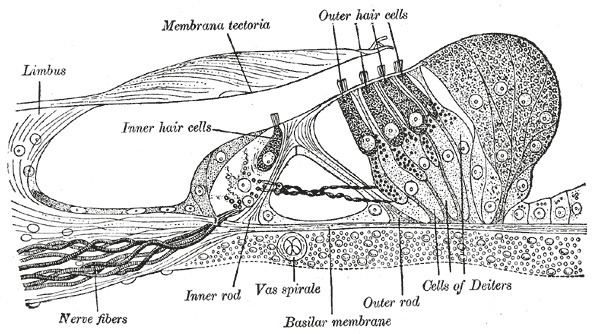 | ||
Auditory neuropathy (AN) is a variety of hearing loss in which the outer hair cells within the cochlea are present and functional, but sound information is not faithfully transmitted to the auditory nerve and brain properly. Also known as Auditory Neuropathy/Auditory Dys-synchrony (AN/AD) or Auditory Neuropathy Spectrum Disorder (ANSD).
Contents
A neuropathy usually refers to a disease of the peripheral nerve or nerves, but the auditory nerve itself is not always affected in Auditory Neuropathy Spectrum Disorders.
Possible Sites of Lesion
Based on clinical testing of subjects with auditory neuropathy, the disruption in the stream of sound information has been localized to one or more of three probable locations: the inner hair cells of the cochlea, the synapse between the inner hair cells and the auditory nerve, or a lesion of the ascending auditory nerve itself.
Diagnosing Auditory Neuropathy
Diagnosis is possible after a test battery, that must necessarily include the following: the auditory brainstem response and otoacoustic emissions. Auditory brainstem response should be tested with both polarities (helps in identifying Cochlear Microphonics).
Auditory neuropathy is diagnosed when a person has present Otoacoustic Emissions and/or Cochlear Microphonics in combination with absent or abnormal Auditory Brainstem Response. Changing the polarity of the stimulus will result in an inversion of the cochlear microphonic. Patients with Auditory Neuropathy Spectrum Disorders have to date never been shown to have normal middle ear muscle reflexes at 95 dB HL or less despite having normal otoacoustic emissions.
Auditory Neuropathy can occur spontaneously, or in combination with diseases like Charcot-Marie-Tooth disease and Friedreich's ataxia.
It appears that regardless of the audiometric pattern(hearing thresholds) or of their function on traditional speech testing in quiet the vast majority of sufferers have very poor hearing in background noise situations.
Residual Auditory Function
When testing the auditory system, there really is no characteristic presentation on the audiogram.
When diagnosing someone with auditory neuropathy, there is no characteristic level of functioning either. People can present relatively little dysfunction other than problems of hearing speech in noise, or can present as completely deaf and gaining no useful information from auditory signals.
Hearing aids are sometimes prescribed, with mixed success.
Some people with auditory neuropathy obtain cochlear implants, also with mixed success.
Screening
Universal Newborn Hearing Screenings (UNHS) is mandated in a majority of the United States. Auditory neuropathy is sometimes difficult to catch right away, even with these precautions in place. Parental suspicion of a hearing loss is a trustworthy screening tool for hearing loss, too; if it is suspected, that is sufficient reason to seek a hearing evaluation from an audiologist.
In most parts of Australia, hearing screening via AABR testing is mandated, meaning that essentially all congenital (i.e., not those related to later onset degenerative disorders) auditory neuropathy cases should be diagnosed at birth.
